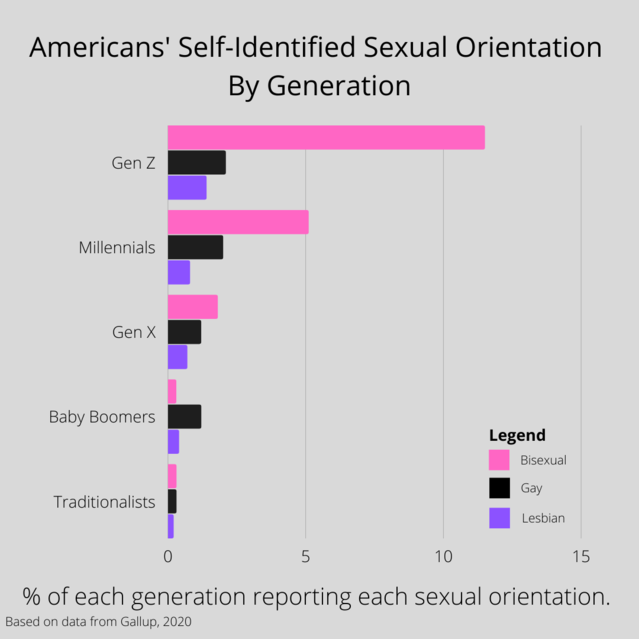Identity
Is a Lesbian, Gay or Bisexual Identity More Common Today?
New data show higher percentages of lesbian, gay and bisexual identities.
Posted March 28, 2021 Reviewed by Abigail Fagan
Recent survey data in the US and the UK revealed that the proportion of the population who identifies as lesbian, gay, or bisexual has risen slightly and that this trend is particularly salient among the youngest generation: Generation Z.
In the UK, only a slight majority of Gen Z members indicate that they have an exclusively heterosexual attraction, while in the US, a Gallup poll indicates that roughly 15% of Gen Z identifies as lesbian, gay, or bisexual – compared to 7.9% of the next youngest generation, the Millennials. When going back as far as the Baby Boomer generation, only 1.9% identify as lesbian, gay, or bisexual when asked about their sexual identity today. Thus, on the surface, it certainly does appear that non-heterosexual sexual orientations are on the rise.

Are young people more sexually fluid than their predecessors?
Sexual fluidity refers to the degree to which an individual’s sexual attraction to partners of various genders may change (or be fluid) over their lifespan. Thus, the recent poll data released in both the UK and the US do not truly speak to the question of sexual fluidity. People were asked to report their sexual identity “today,” in the present, and not asked to indicate how much their attractions have changed over time. Thus, while 1.9% of the Baby Boomers surveyed in the US indicated they were not heterosexual, many more may have still had same-sex experiences throughout their lifespan, but they simply do not firmly identify as lesbian, gay, or bisexual.
It may very well be that younger generations experience greater sexual fluidity than older generations, but the recent reports do not speak to this question. Indeed, people are now more aware of the fact that sexual fluidity exists and that it may not make as much sense to firmly declare one type of monosexual orientation (attraction to only one or the other sex/gender) at any given point in time, as there is always the possibility that life experiences may lead to a change in attractions.
Other research has found that many young people today tend to shy away from firm labels when it comes to their sexual identities, thereby keeping their options open, allowing them to explore their sexual identities in the same way that they explore any other aspect of their developing identities. In previous generations, this kind of exploration was actively discouraged, which may have led many people to simply adopt the norm (heterosexuality) and not give much additional thought to their sexual identity unless it was something so strong that it could not be ignored.
Changes in Attitudes and Civil Liberties
The most notable and obvious explanation for why a greater proportion of Generation Z would identify as non-heterosexual lies simply in the different life experiences this generation has had when it comes to attitudes towards sexual diversity. It is much easier to come out today as lesbian, gay, or bisexual than it was even just 10 years ago, let alone 20, 30, 40 or 50 years ago. The social world of Gen Z individuals is drastically different than all the other generations polled.
They have grown up in a time where their adult lives have always included legalized same-sex marriage in most Western nations as well as widespread anti-discrimination laws. The TV shows and movies that they watched while growing up included LGBTQ characters as something more than the butt of a joke. Thus, it is not that surprising that members of Gen Z would be more willing or able to give thought and consideration to their sexual identity in ways that simply were not feasible for past generations. Even as recently as the Millennial generation, it was still common to grow up believing that the only "normal" option was to be heterosexual, and the strength and ubiquity of such cultural messaging only increases as you go further back in time.
When looking at how individuals across generations respond to a question about their sexual identity today, we do not just have to consider the current social and political climates. Even though people are answering the question today and therefore anyone of any age could conceivably enjoy the same sexual freedoms and civil liberties that those in Generation Z experience, individuals who grew up in past generations are still shaped by the social and political climates of their times, especially those that were prevalent when they were coming of age. Nearly every generation prior to the Millennials grew up during a time when there was still great social and even legal persecution directed at sexual minorities.
In Canada, for example, any individual 53 years of age or older in 2021 was born at a time when homosexuality was a criminal offence. In the United States, the last law against sodomy was not removed until 2003. Thus, individuals who grew up and came of age in a time when same-sex sexuality was not only socially shunned but also criminally prosecuted are going to be much less likely to have explored their sexuality in their youth. Indeed, some individuals may have been gay, lesbian, or bisexual and simply never came out to even themselves.
What was the impact of the HIV/AIDS epidemic?
There is, however, also a much darker explanation for why we see fewer individuals from past generations identifying as lesbian, gay, or bisexual today than we do from the younger generations. The chances are quite high that many of the individuals from previous generations who did identify as non-heterosexual are no longer alive to answer a Gallup poll today. The elephant in the room is HIV/AIDS epidemic that claimed nearly an entire generation of gay and bisexual men.
Gay and bisexual men from the Baby Boomer generation were between 16 and 34 years of age at the peak of the HIV/AIDS epidemic in North America. While it is impossible to ever have accurate population statistics on a hidden population, it is estimated that at least 10% of gay men in the United States between the ages of 25 and 44 had died by 1995. In the year 1990 alone, AIDS was the cause of death of 61% of all men aged 25-44 in San Francisco. Similarly striking numbers were found across major cities in the US with large gay populations. Thus, any attempt to “count” the number of gay men in the Baby Boomer or Gen X generations needs to consider the number of people who are simply no longer alive to answer the question.
Is it easier to imagine a future as a gay person today?
As sexual diversity has become more widely accepted and celebrated, it has become easier for young people to envision a happy future with a partner of any gender. Today, there is simply not the same degree of restraints placed upon young people in terms of their sexual identities relative to what was faced by previous generations. The only two generations alive today who have not personally faced the criminalization of their sexual identities within a Western nation are the Millennials and those from Gen Z, and for Gen Z, they have lived their entire lives in a social climate that has moved from mere tolerance to, in many cases, sincere acceptance and even celebration of sexual diversity.

Increased acceptance may be especially important to explaining the most drastic increase across generations – the increase in the percentage of individuals identifying as bisexual. In the US data, the percentage of individuals identifying as lesbian or gay has increased, but not nearly as much as the percentage of those identifying as bisexual (.03% of baby boomers, 1.8% of Generation X, 5.1% of Millennials and 11.5% of Gen Z).
Here we are likely seeing a few different elements at play. The greater acceptance allows more people to acknowledge their sexual fluidity, and one way of doing that may be to identify as bisexual. Additionally, bisexuals have always faced somewhat a catch-22 in which they are both rejected by the heterosexual community for being a sexual minority and from the lesbian and gay community for not quite being “gay enough.” However, the assumption that people’s sexual identities need to conform to monosexual principles (attraction to one gender or another) had continuously reduced over time – in both heterosexual and sexual minority communities, thus likely making it easier to identify as a bisexual today than in any previous generation.
Overall, it is unlikely that the underlying biological mechanisms at play in determining our sexual attractions have changed within the span of only a few decades. Our social cultures and norms evolve much more quickly than our genes. Sexuality has not become more fluid than it was, we have simply become more accepting, thereby allowing young people to be more sexually fluid, to explore their sexual identities honestly, and to ultimately be open about their sexual identities – especially when speaking to poll takers!
Of course, while there are clear differences between the generations, this is not to say that members of Gen Z face no challenges whatsoever when it comes to acknowledging their sexual identities. Sexual prejudice still exists and can be quite persistent in certain subgroups of society. Thus, not all young people today come out to supportive and accepting families. Hate crimes against LGBTQ individuals still exist and everyone has a unique coming-out experience. Still, it is promising to see that experiences across generations point to it being much easier and safer to be a sexual minority today than ever before in recent history.
References
Rosenfeld, D. (February 18, 2018). The AIDS epidemic's lasting impact on gay men. The British Academy Blog.
Jones, J. (February 24, 2021). LGBT Identification Rises to 5.6% in Latest US Estimate. Gallup.
Diamond, L. M. (2021). The New Genetic Evidence on Same-Gender Sexuality: Implications for Sexual Fluidity and Multiple Forms of Sexual Diversity. The Journal of Sex Research, 1-20.
Diamond, L. M., Alley, J., Dickenson, J., & Blair, K. L. (2019). Who counts as sexually fluid? comparing four different types of sexual fluidity in women. Archives of Sexual Behavior, 49, 2389–2403




